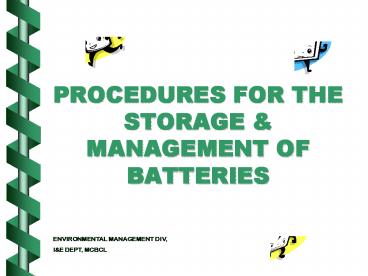PROCEDURES FOR THE STORAGE & MANAGEMENT OF BATTERIES - PowerPoint PPT Presentation
1 / 18
Title:
PROCEDURES FOR THE STORAGE & MANAGEMENT OF BATTERIES
Description:
PROCEDURES FOR THE STORAGE & MANAGEMENT OF BATTERIES ENVIRONMENTAL MANAGEMENT DIV, I&E DEPT, MCBCL BACKGROUND The Resource Conservation and Recovery Act (RCRA) sets ... – PowerPoint PPT presentation
Number of Views:52
Avg rating:3.0/5.0
Title: PROCEDURES FOR THE STORAGE & MANAGEMENT OF BATTERIES
1
PROCEDURES FOR THESTORAGE MANAGEMENT OF
BATTERIES
ENVIRONMENTAL MANAGEMENT DIV, IE DEPT, MCBCL
2
BACKGROUND
- The Resource Conservation and Recovery Act (RCRA)
sets the requirements for the management of
Hazardous and Solid Wastes in the United States. - Batteries are not specifically regulated under
RCRA. - However batteries may exhibit one or more of
the characteristics of Hazardous Waste (HW) and
would be managed as such. Hazardous Waste
characteristics as defined by RCRA include
Ignitability, Corrosivity, Reactivity, and or
Toxicity.
3
EXAMPLES OF TYPES OF BATTERIES FOUND AT CAMP
LEJEUNE
4
The Management of Batteries starts from the time
a command
- Purchases batteries from the military supply
system - OR
- Purchases batteries from an outside vendor
5
GENERAL STORAGE REQUIREMENTS
- Batteries shall be stored in a cool, well
ventilated, dry storage area
While the picture above may look like an adequate
storage area, notice the radiator along the wall.
The picture above shows a well ventilated, dry
storage area.
6
Battery Storage ( Cont)
- Batteries shall be protected against being
damaged, punctured or short circuited. - If damage is observed batteries shall immediately
be turned in on the next turn-in day to the
Environmental Management Division (EMD)
Consolidation Site for disposal
DAMAGED BATTERIES
7
Battery Storage (Cont)
- Do not smoke or eat in battery storage areas.
Smoking can ignite vapors that vent from
batteries. - Eating and/or drinking in battery storage
areas can cause health problems such as burns,
rashes,etc.
Food items located in storage box for batteries
8
Battery Storage (Cont)
- Batteries shall be stored separate from all other
hazardous waste and hazardous materials. - Hazardous Materials can react with venting
batteries and cause adverse events such as fire
or explosion to occur.
9
Battery Charging shall be conducted on a
non-flammable surface only in authorized areas
10
COMMUNICATION BATTERIES SPECIFIC MANAGEMENT
PRACTICES
All communication batteries shall remain bagged
boxed until used.
11
- Lithium Batteries shall not be stored in the same
stack as any other battery. - A venting Lithium battery will react with water
and cause a violent reaction. Lithium will
potentially react with other venting batteries
the same way.
- The above picture shows lithium batteries upper
left corner being stored with Nickel Cadmium
batteries. The result was leaking batteries that
could have caused a fire or explosion.
The picture to the right shows Lithium thrown
in a pile with other batteries
12
Shelf Life of Batteries is handled the same way
as other Hazardous Materials. At a minimum, the
battery must be labeled with the date of initial
inspection, re-inspection date (usually 1 year)
and the inspectors initials.
Contact EMD (451-1482) for more information
regarding shelf-life extensions for batteries
13
For Units with Universal Waste Sites (UWSs) for
Communication Batteries
- Ensure all labeling requirements are met
- Personnel responsible for managing the UWS must
- have attended EM101 training
- Battery terminals should be covered with
electrical or duct tape prior to placing in the
UWS Accumulation Start Date (ASD) goes on drum
when 1st battery is placed in it
14
WET-CELL/SEALED LEAD ACID BATTERIES SPECIFIC
MANAGEMENT PRACTICES
- Upon receipt, fill batteries with sulfuric acid
1st, followed by water NO ACID SHOULD BE LEFT - If acid is remaining - Turn in to EMD
- Refilling batteries w/ acid is NOT AUTHORIZED
- Stack batteries no more that 2 high on pallets
15
Examples of Improper Battery Storage
The picture above shows Arabic language on the
battery. This would not be acceptable unless you
were in a host nation that uses them.
In the picture above, wet cell batteries have
been placed around the lithium battery UWS.
Notice the 1-2 of water on the floor.
- The picture to the right shows improperly
stored batteries. The batteries pictured do not
have shelf life labels affixed to them
16
- Batteries are turned in at the EMD Consolidation
Center on Michael Road. Command ECCs ECOs must
ensure that the batteries are - Properly packaged for transportation
- Properly Marked
- Properly identified by type
- Properly secured
- Are only transported in cargo variant Government
or contractor-owned vehicles
17
REMEMBER........
Prior to purchasing batteries, always check first
with the HAZMART located in Bldg 908 (across
the street from the Consolidation Center Phone
451-1718)
YOU MAY GET THEM FREE!!
18
- Manage Used Batteries in a Sound and
Environmental Manner - Store batteries in such a way as to prevent
damage, leaks and spills - Reuse or recycle batteries when possible
- Turn-in batteries that are no longer serviceable
to EMD on your appropriate turn-in day
QUESTIONS? Contact EMD at 451-1482































